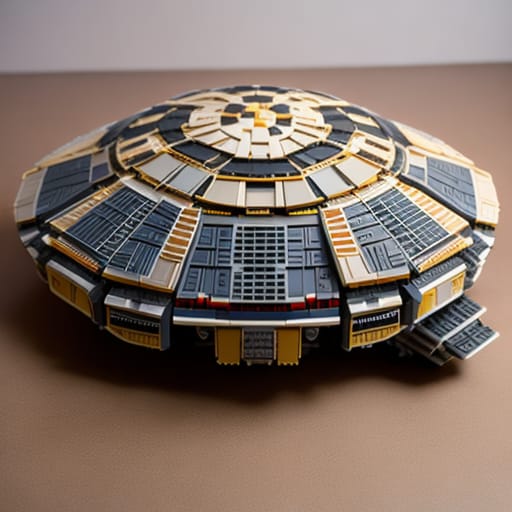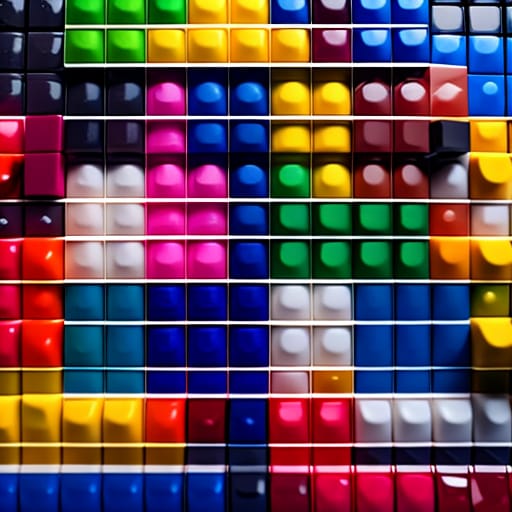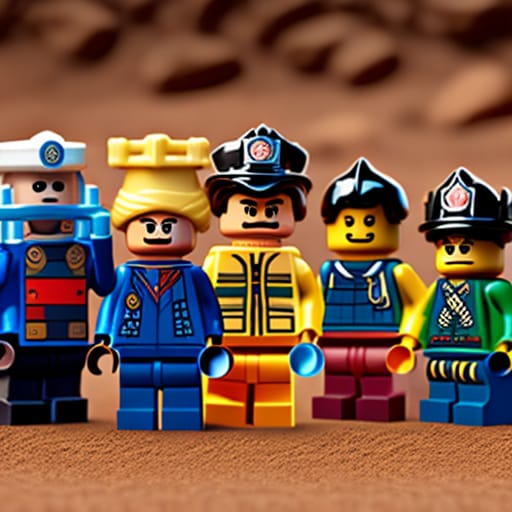From simple wooden blocks to high-tech robotic kits, construction toys have fueled the imaginations of children and adults alike for generations. Of all construction toys, perhaps none has had quite the cultural impact and global appeal of LEGO, the iconic interlocking plastic bricks that serve as the building blocks for creativity.
With over 500 billion LEGO bricks produced since 1958, LEGO has established itself as a universal language of creative play. The LEGO system’s uniform bricks, plates, tiles, minifigures, and other parts can be assembled and reassembled into virtually anything a builder can conjure up. This simplicity, coupled with endless possibility, is at the heart of LEGO’s enduring popularity with children and its growing legions of Adult Fans of LEGO (AFOLs).
But LEGO is far from the only construction toy on the market today. From other brick-based building systems like Mega Bloks to revolutionary newcomers like Magformers magnetic building sets, the construction toys segment continues to innovate and expand.
This guide aims to cover everything a beginner needs to know about LEGO and the wider world of construction toys. Read on to learn about:
- The educational benefits of building blocks and construction toys
- Market size and growth trends in the construction toys industry
- Research findings on the impact of LEGO and similar toys on child development
- Innovations in brick-based toy manufacturing and design
- The thriving culture of AFOLs and LEGO enthusiasts
- Safety standards and regulations for toy building sets
- The future of high-tech “smart” construction toys with digital integration
- And much more about the past, present and future of LEGO!
So let’s start stacking those plastic bricks and unlock the power of creative construction play!
The Importance of Building Blocks Play
It may seem simple on the surface, but play with interlocking block sets like LEGO have powerful developmental benefits for children. Physical manipulation of modular construction parts builds hand-eye coordination and fine motor skills, while following assembly instructions exercises spatial reasoning ability.
Construction toys provide the foundation to develop these STEM abilities from toddlerhood into the school years.
In fact in a recent survey, 89% of teachers said they utilize LEGO-based education materials in the classroom. The tangible, hands-on qualities of brick building sets have proven to effectively promote learning in core academic subjects like science, engineering and technology.
This strong educational value explains why LEGO and other building block sets maintain timeless appeal across generations.
“Play is often talked about as if it were relief from serious learning. But for children, play is serious learning. Play is really the work of childhood.” – Mr. Rogers
While parents may see a bunch of plastic bricks, kids see the raw materials to construct an airport, dinosaur exhibit or fairytale kingdom limited only by their imagination.
Open-ended play with versatile construction toys like LEGO, Mega Bloks, and Magna-Tiles grants kids the freedom to experiment and problem-solve, developing persistency and critical thinking skills that will serve them throughout life.
The LEGO System: Key Parts and Terms
The word LEGO itself comes from the Danish phrase “leg godt” meaning “play well”. And playing well often means mastering the diverse array of over 3,000 LEGO elements that can snap together in a variety of ways to build virtually anything.
Here are some of the most common types of LEGO pieces and key terminology to know:
LEGO Bricks
The basic rectangular blocks that form the foundation of any LEGO creation. From standard 2×4 bricks to circular bricks to decorative bricks with molded details, these are the classic LEGO pieces that started it all. Bricks stack and interlock to form strong, stable creations.
Plates
Thin, flat pieces that offer detailing, texturing and shaping possibilities for LEGO builds. Plates come in a variety sizes and styles from tiny 1×1 rounds to large 16×16 squares.
Tiles
Very similar to plates but without the hollow studs on top, tiles create completely smooth surfaces and face details. Transparent window tiles, printed detail tiles and more help builders enhance their designs.
Slopes and Roofs
Angled bricks that span 45 to 75 degree angles enable builders to create sloped surfaces, arched details, roofs and more. Inverted slopes offer even more shaping freedom.
Minifigures
The iconic LEGO people with movable arms, legs and hands that populate LEGO sets. First introduced in 1978, minifigures bring unlimited roleplaying fun and customization with a wide variety of facial expressions, outfits, accessories and occupations.
These are just a taste of the many types of specialized LEGO elements beyond basic bricks. As LEGO sets have become more complex, pieces like gears, treads, ball joints and liftarms have entered the mix as well.
With new elements still being added, part variety continues to grow, leading to even more creativity. LEGO has also coined specific terminology for building techniques that enhance design possibilities:
AFOL (Adult Fan of LEGO)
The 18+ age demographic now accounts for 1 in 5 LEGO customers. AFOLs engineers, architects and artists push the creative envelope of LEGO. There’s even a yearly AFOL convention called Brickworld.
MOC (My Own Creation)
A MOC refers to any originaI model designed rather than being built from a set. MOCers endlessly inspire each other by posting photos of custom creations online.
SNOT (Studs Not on Top)
SNOT describes unconventional sideways and even upside-down building techniques that enable intricate designs. SNOT introduces advanced problem solving and spatial skills.
LUG (LEGO User Group)
Local fan communities that meet to discuss and display LEGO creations. LUGs demonstrate the thriving culture and networking power amongst AFOLs.
Now that the basic building blocks of LEGO lingo are covered, let’s analyze the business side of construction toys.

Construction Toy Industry Growth
Construction toys now form a nearly $9 billion dollar industry globally, one that has demonstrated strong and steady growth, especially coming off the COVID-19 pandemic. In fact 2020 saw a 16% boost in sales even with lockdowns and economic disruption.
Parents turned to open-ended building toys like LEGO to stimulate and engage children during remote schooling. These positive pandemic trends have continued into 2022 with over 10% growth. And the global toy market as a whole is projected to grow at a 6% rate annually through 2025.
The bricks and blocks segment makes up over 25% of total global toy sales and should continue to expand at a 7% annual pace. Asia Pacific regions including China, India and Indonesia will power much of this growth based on rising disposable incomes and an emerging middle class.
Educational construction toys are also at the forefront of the “Kidfluencer” social media phenomenon where children demonstrate STEM toys on YouTube channels like Ryan’s World which made $200 million in ad revenue in 2019. This integration with digital platforms expands marketing and engagement potential.
LEGO Leads Construction Toy Market
The LEGO brand utterly dominates the construction category. After posting record profits of over $8 billion in 2021, the Danish company now controls roughly 70% market share in the bricks & blocks segment. And LEGO’s profits have increased by over 50% in the last 6 years.
In an ever-growing toy industry, no company has shown quite the product innovation, brand consistency and international appeal as LEGO. Some keys to their winning formula:
Compatibility – Unlike some competitors, every LEGO piece still fits every other LEGO piece ever made, meaning kids inherit a creative legacy.
Storytelling – Entire fantastic worlds like NINJAGO City and Star Wars spacecraft inspire adventure.
Timelessness – From the 1958 original bricks to 2022’s new globe set, LEGO never stops innovating.
Sustainability – LEGO plans for 100% plant-based bricks by 2030. And those bricks last nearly indefinitely.
A continually refreshed LEGO portfolio including licensed sets from Disney properties and brickbuilt versions of icons like the Titanic engage young builders. Not even challenging patent expirations that allow cheaper toy clones have slowed LEGO’s roll.
Parents may wince at the higher price tag compared to generic bricks, butLEGO’s trusted universal quality and play value make them more than worth the cost.
Developmental Benefits of Building Toys
The benefits of manipulative brick and block play extend far beyond basic motor skills. A wealth of studies have recently reinforced the tangible developmental impacts building toys impart on the cognitive, social-emotional and academic growth of children.
For example, a two-year research project from the LEGO Foundation involving 1600 children focused specifically on early years development using LEGO DUPLO bricks. The findings were extremely positive:
- Over 69% of children demonstrated growth in creative problem solving abilities
- Over 62% improved in emotional management capacities
- Over 74% showed increased positive social interactions
Additionally the study showed correlation between LEGO DUPLO play and boosted early math learning outcomes including numbering skills, adding and subtracting and shape recognition.
Other major studies note the improvement spatial intelligence, mental rotation abilities and risk-taking behavior in both boys and girls given construction toys like LEGO. This data continues to shape LEGO’s evidence-based marketing and product development.
It’s clear pretend play serves as far more than mere diversion. As kids incorporate LEGO and other building sets into role playing stories, imitation play enhances flexibility, self-regulation and symbolic representation which bleeds over into academic disciplines.
Open-ended bricks without strict instructions also encourage free building and tinkering which powers innovation skills. All evidence continues to reveal construction toys as ideal learning tools integrating both sides of a child’s brain during pivotal developmental windows.

Smart Bricks – The Future of Interactive Construction Toys
From plastic to chip-enabled, the building blocks of tomorrow promise to add digital integration into the mix for even greater creative possibilities.
Enter studs-embedded programmable bricks like LEGO’s WeDo robotics kits where over 1000 components are controllable by tablet software.
This early experiment in smart construction toys led to the LEGO Life app for iOS and Android which unlocks step-by-step building instructions and social sharing features.
Other innovators like Denmark startup LEGO-LIKE is developing their CODI range of programmable building blocks for customizable creatures and vehicles.
Building an Inclusive Brick-Based Community
In recent years the LEGO Group has made concerted efforts to make their iconic toys more inclusive and diverse.
Adding representation into new minifigure lines as well as consultations with community organizations, children’s museums and even parents, LEGO is improving ethnic diversity in their sets.
In 2020, LEGO experimented by leaving the gender of a community play set minifigure ambiguous and non-binary, allowing kids to decide themselves.
By giving customers the creative freedom to customize, LEGO empowers identity exploration and self-expression through an unlimited matrix of bricks.
Construction Toys Foster Key Skills
The innate human drive towards mimicry, organized planning, and physical creation finds glorious outlet in toy building brick play.
Studies continue to demonstrate how manipulation of interlocking block sets builds developmental skills from gross motor strength to emotional intelligence as creative areas of the brain are activated through this constructive style of play.
LEGO in particular has become globally iconic by establishing their bricks’ as the cornerstones of creativity across generations. But new digital integration now propels traditional construction toys into an interactive future where virtual and physical building fuse, unlocking even greater innovative potential.
From babies instinctively stacking rings and blocks as their first experiment in physics to school age engineers-in-training constructing mighty shafts and gears to dedicated Adult Fans endlessly expanding the boundaries of brick-based arts, there is no ceiling on what interlocking toy systems can construct within our human experience.
The guiding ethos behind LEGO sets has always been “det bedste er ikke for godt” – Danish for “only the best is good enough”. That endless pursuit of quality and creative possibility is stamped into every stud.
So whether connecting classic bricks or smart blocks, keep imagining, keep building, keep playing. With the solid foundation of construction toys beneath our feet building higher is exhilarating, educational and endless fun. Let the assembly begin!
Conclusion
The versatility of interlocking plastic bricks has captivated children and kid-at-heart adults for over 60 years now.
With roots dating back to 1932 Denmark, the LEGO system itself was born when master carpenter Ole Kirk Christiansen coined the company name by shortening “leg godt” which means “play well” in Danish.
That ethos around creative play for play’s sake continues to drive LEGO’s evolution from wooden toys to global phenomenon.
Today LEGO churns out over 19 billion finely molded ABS plastic elements per year. That’s 2 million molded brick pieces per hour!
In 2015 LEGO also became the world’s largest toy manufacturer by revenue outpacing Mattel’s Barbie doll empire, leading the industry with a projected 6% compound growth rate through 2025.
From programmable elements to big screen entertainment collaborations, LEGO continually sets the gold standard when it comes to capturing youthful imaginations and bringing positive developmental impacts that will last a lifetime.
Because at their simple studded core, LEGO embody essential child’s play. The pure pleasure of creation without limits, structure fused with freedom.
So whether 6 or 60 years old, grab those iconic plastic bricks and build away!
Frequently Asked Questions
What are the benefits of construction toys like LEGO?
Playing with interlocking plastic brick toys like LEGO improves hand-eye coordination, fine motor skills, spatial reasoning, and problem solving abilities. Building block play also boosts creativity, imagination roleplaying skills. Studies show LEGO building specifically enhances early math, science and literacy skills.
What makes LEGO sets unique?
LEGO bricks stand out for trusted quality and compatibility – every brick still fits every set which enables creative reuse and sharing. LEGO’s brand storytelling also brings popular movies and characters to life. Lastly, LEGO stays ahead of toy industry trends with sustainable manufacturing and digital integration advances.
Are LEGO sets worth the price?
Given their unmatched quality and play value, LEGO sets can be a worthwhile investment, especially classic collections which hold or increase value. Buying LEGO bricks also supports fair labor practices. Parents can also watch for sales, participate in LEGO reuse programs or explore compatible cheaper brands.
How do I get started with LEGO as a beginner?
Start by learning the basic building techniques and exploring the key bricks – standard blocks, plates, tiles and minifigures. Allow experimentation and don’t limit based on age ranges. Seek inspiration from LEGO communities online and consider attending a fan event. For kids, Duplo sets specially sized for little hands teach fundamentals.
Is there a future for tech-enhanced construction toys?
Smart programmable building blocks signal the next evolution for STEM toys. LEGO already offers coding-focused sets like Boost for creating motorized models while startups like LEGO-LIKE integrate mobile apps with enhanced interlocking bricks. Voice control, virtual/augmented reality features and 3D printing may be integrated as well.
